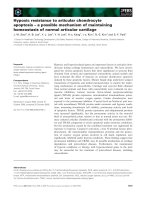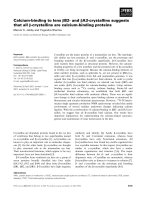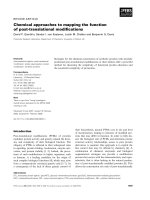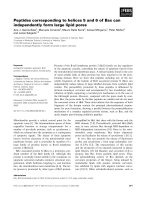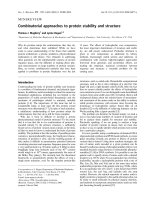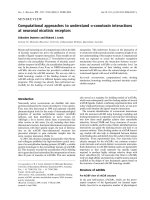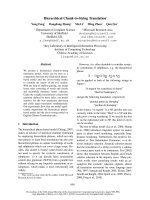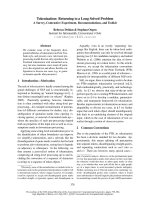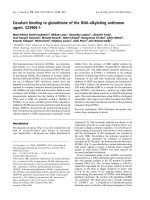báo cáo khoa học: "From recommendation to action: psychosocial factors influencing physician intention to use Health Technology Assessment (HTA) recommendations" pot
Bạn đang xem bản rút gọn của tài liệu. Xem và tải ngay bản đầy đủ của tài liệu tại đây (338.53 KB, 11 trang )
BioMed Central
Page 1 of 11
(page number not for citation purposes)
Implementation Science
Open Access
Research article
From recommendation to action: psychosocial factors influencing
physician intention to use Health Technology Assessment (HTA)
recommendations
Marie-Pierre Gagnon*
1
, Emília Sánchez
2
and Joan MV Pons
2
Address:
1
Evaluative Research Unit, Quebec University Hospital Centre, Quebec, Canada and
2
Catalan Agency for Health Technology Assessment
and Research (CAHTAR), Barcelona, Spain
Email: Marie-Pierre Gagnon* - ; Emília Sánchez - ;
Joan MV Pons -
* Corresponding author
Abstract
Background: Evaluating the impact of recommendations based upon health technology assessment (HTA)
represents a challenge for both HTA agencies and healthcare policy-makers. Using a psychosocial theoretical
framework, this study aimed at exploring the factors affecting physician intention to adopt HTA
recommendations. The selected recommendations were prioritisation systems for patients on waiting lists for
two surgical procedures: hip and knee replacement and cataract surgery.
Methods: Determinants of physician intention to use HTA recommendations for patient prioritisation were
assessed by a questionnaire based upon the Theory of Interpersonal Behaviour. A total of 96 physicians from two
medical specialties (ophthalmology and orthopaedic surgery) responded to the questionnaire (response rate
44.2%). A multiple analysis of variance (MANOVA) was performed to assess differences between medical
specialties on the set of theoretical variables. Given the main effect difference between specialties, two regression
models were tested separately to assess the psychosocial determinants of physician intention to use HTA
recommendations for the prioritisation of patients on waiting lists for surgical procedures.
Results: Factors influencing physician intention to use HTA recommendations differ between groups of
specialists. Intention to use the prioritisation system for patients on waiting lists for cataract surgery among
ophthalmologists was related to attitude towards the behaviour, social norms, as well as personal normative
beliefs. Intention to use HTA recommendations for patient prioritisation for hip and knee replacement among
orthopaedic surgeons was explained by: perception of conditions that facilitated the realisation of the behaviour,
personal normative beliefs, and habit of using HTA recommendations in clinical work.
Conclusion: This study offers a model to assess factors influencing the intention to adopt recommendations
from health technology assessment into professional practice. Results identify determinant factors that should be
considered in the elaboration of strategies to support the implementation of evidence-based practice, with
respect to emerging health technologies and modalities of practice. However, it is important to emphasise that
behavioural determinants of evidence-based practice vary according to the specific technology considered.
Evidence-based implementation of HTA recommendations, as well as other evidence-based practices, should
build on a theoretical understanding of the complex forces that shape the practice of healthcare professionals.
Published: 31 March 2006
Implementation Science2006, 1:8 doi:10.1186/1748-5908-1-8
Received: 16 December 2005
Accepted: 31 March 2006
This article is available from: />© 2006Gagnon et al; licensee BioMed Central Ltd.
This is an Open Access article distributed under the terms of the Creative Commons Attribution License ( />),
which permits unrestricted use, distribution, and reproduction in any medium, provided the original work is properly cited.
Implementation Science 2006, 1:8 />Page 2 of 11
(page number not for citation purposes)
Background
Health Technology Assessment (HTA) is a multidiscipli-
nary field of applied research that aims to provide the best
evidence available on health technologies in order to
inform policy-making [1,2]. In HTA, the definition of
health technology is broad and encompasses all methods
used by health professionals to promote health, prevent
and treat disease, and improve rehabilitation and long-
term care [3].
It is generally recognised that there is a gap between the
production of scientific evidence and its utilisation to
inform decision-making, [4], and this also applies to the
field of HTA [5-8]. Despite growing interest in HTA, both
in the governmental and scientific spheres, few efforts
have been made to assess HTA impact on decision-mak-
ing at different levels of the healthcare system [6]. Further-
more, there is a paucity of specific methodologies and
tools to assess the uptake of HTA recommendations [5].
At the health policy level, previous work has reported that
HTA recommendations could influence decision-making
[9-11]. According to a multi-method study of the imple-
mentation of guidance issued by the National Institute for
Clinical Excellence (NICE) in England and Wales, [12] the
extent to which HTA led to changes in practices was varia-
ble. Moreover, a review of HTA utilisation in four Euro-
pean countries indicates that, in spite of substantial
human and financial investments, the actual impact of
HTA on policy-making was still limited [13].
Hivon and collaborators have explored end-users' percep-
tions and use of HTA recommendations [14]. Their find-
ings indicate that knowledge produced from HTA was not
always used directly in decision-making, but could serve
various purposes. According to these authors, HTA recom-
mendations could have an instrumental, conceptual or sym-
bolic use in decision-making [14]. Instrumental use
implies that recommendations from HTA are directly
translated into a decision. HTA recommendations also
can have a conceptual use by providing a knowledge basis
for debate and positioning. Finally, decision-makers can
make a symbolic use of HTA recommendations, using
them to reinforce or justify their decisions. Thus, studies
assessing HTA utilisation should explore the various pur-
poses that scientific evidence can serve in the formulation
of healthcare policies.
At the healthcare organisations level, the implementation
of hospital-based HTA activities could represent a strategy
to improve practices [7]. Hospital-based HTA is believed
to provide scientific evidence that is context-relevant,
which would eventually lead to the adoption of best prac-
tices [15,16]. Experiences with HTA activities in hospitals
have reported positive impact on resources and costs [15].
Other experiences of decentralized HTA activities include
the implementation of units dedicated to HTA at the
regional health authority level, such as in Health Regions
in Canada [17]. However, evidence is still lacking on how
HTA activities should be integrated within healthcare
organisations [18].
Until now, little is known about the implementation of
HTA recommendations at the individual level, i.e. in the
daily practice of healthcare professionals. However, the
literature on physician adoption of scientific evidence and
interventions to improve it is extensive [19]. Thus, it is
possible to draw from this body of knowledge in order to
better understand the mechanisms involved in the adop-
tion of HTA recommendations into clinical practices.
Theoretical foundations
In the field of social psychology, various theories and
models have been proposed to understand what influ-
ences the adoption of behaviours. Triandis' Theory of
Interpersonal Behaviour (TIB) [20] encompasses many of
the behavioural determinants found in other psychosocial
theories, such as the Theory of Planed Behaviour [21] and
the Social Cognitive Theory [22]. Moreover, the TIB also
considers cultural, social, and moral factors that are par-
ticularly important in the study of specific groups, such as
healthcare professionals [23,24].
A schema adapted from the TIB is presented in Figure 1.
According to this theory, human behaviour is formed by
three components: intention, facilitating conditions, and
Theoretical ModelFigure 1
Theoretical Model Adapted from Triandis' Theory of
Interpersonal Behaviour [22]
Figures
Figure 1 - Theoretical Model
Adapted from Triandis’ Theory of Interpersonal Behaviour [22]
Tested hypothesis Non-tested hypothesis New hypothesis
Affect
HABIT
Perceived
consequences
INTENTION
FACILITATING
CONDITIONS
Personal
norm
BEHAVIOUR
Role
beliefs
Normative
beliefs
SOCIAL NORMATIVE
BELIEFS
Self -
identity
PERSONAL
NORMATIVE BELIEFS
ATTITUDINAL
BELIEFS
Profes-
sional
norm
Dimension added
Implementation Science 2006, 1:8 />Page 3 of 11
(page number not for citation purposes)
habit. Intention refers to the individual's motivation
regarding the performance of a given behaviour. Facilitat-
ing conditions represent perceived factors in the environ-
ment that can ease or impede the realisation of a given
behaviour. Habit refers to how routine a given behaviour
has become, i.e. the frequency of its occurrence. Habit
directly influences the behaviour, but can also have an
influence on affect. However, this hypothesis was not
tested in the present study.
In the TIB, the behavioural intention is formed by attitu-
dinal as well as normative beliefs. Attitudinal beliefs com-
prise two dimensions: affect and perceived consequences.
Affect represents an emotional state that the performance
of a given behaviour evokes for an individual. It is consid-
ered as the affective perceived consequences of the behav-
iour, whereas perceived consequences refer to individual's
perception of the instrumental consequences of the
behaviour.
The TIB also distinguishes between two normative dimen-
sions: social and personal. Social normative beliefs are
formed by normative and role beliefs. Normative beliefs
consist of the internalisation by an individual of referent
people's or groups' opinions about the realisation of the
behaviour, whereas role beliefs reflect the extent to which
an individual thinks someone of his or her age, gender,
and social position should or should not behave. With
respect to the personal normative beliefs, personal norm
represents the feeling of personal obligation regarding the
performance of a given behaviour, whereas self-identity
refers to the degree of congruence between the individ-
ual's perception of self and the characteristics associated
with the realisation of the behaviour.
For the purpose of this study, modifications were brought
to the original TIB model. These modifications were con-
sistent with a previous study that has adapted the TIB to
understand healthcare professional behaviour [24]. First,
the dependent variable of interest in this study is the
behavioural intention rather than the behaviour. Thus,
the original relationships between facilitating conditions
and behaviour, as well as between habit and behaviour
have been modified to explore the influence of these con-
structs on the behavioural intention. These relationships
are consistent with previous studies that used the TIB to
predict behavioural intention [25-27].
Furthermore, in an effort to better adapt the TIB to health
professional behaviour, another dimension was added to
the personal normative beliefs – the professional norm. This
variable is related to the integration by the self of the spe-
cific normative pressures of one's professional group. The
medical profession has a particular culture and sets of
norms (e.g. the Hippocratic Oath) that also influence
individual physician behaviour [28]. In a previous study,
adding the professional norm to the personal normative
construct significantly improved the predictive validity of
this construct in explaining physicians' decision to adopt
a new technology [24]. This construct is also consistent
with the concept of collective self, as proposed by Triandis,
which corresponds to the individual's assessment of how
she or he should behave given her or his belonging to a
specific reference group [29]. The professional norm is
considered a of the dimension of the personal normative
construct since previous work has shown association
between these factors [24].
To the best of our knowledge, the TIB has not previously
been applied to the study of the adoption of evidence-
based recommendations into medical practice. However,
this model was successful in explaining a variety of profes-
sional behaviours, such as the adoption of information
and communication technologies [24,25,30,31].
Description of the study
This study is part of a larger initiative aimed at applying a
multi-dimensional theoretical framework to assess the
impact of HTA recommendations on decision-making at
different levels of the healthcare system. Thus, various
methods were used in order to assess factors influencing
the uptake of HTA recommendations at the healthcare
organisation and clinical decision-making levels. HTA
adoption at the organisational level was assessed through
a qualitative approach by means of interviews and obser-
vations at 15 hospitals of Catalonia. The results of the
qualitative study are presented elsewhere [32,33].
In summary, the qualitative study indicates that factors
related to the organisation and financing of the health sys-
tem influence adoption of HTA recommendations at the
hospital level. Furthermore, collaborations between hos-
pitals and the HTA agency favour the integration of rec-
ommendations into organisational practices. At the
professional level, the high degree of autonomy of medi-
cal specialists, the importance of peers and collegial con-
trol, and the definition of professional roles and
responsibilities influence adoption of HTA recommenda-
tions.
The present article focuses on the impact of HTA recom-
mendations at the individual level, which has been con-
ceptualised as physician intention to use HTA
recommendations to support clinical decision-making.
This study was conducted as part of a postdoctoral fellow-
ship (MPG), and the research protocol was approved by
Catalonia and Quebec governments. The Catalan Agency
for Health Technology Assessment and Research
(CAHTAR) also reviewed the research protocol and pro-
vided support for the study.
Implementation Science 2006, 1:8 />Page 4 of 11
(page number not for citation purposes)
Research Questions
Based upon the TIB, this study aimed to answer the fol-
lowing questions:
1. Which psychosocial factors from the TIB (attitudinal
beliefs, social normative beliefs, personal normative
beliefs, facilitating conditions, habit) significantly explain
the intention of physicians to adopt these recommenda-
tions into their practice?
2. Are the psychosocial factors influencing physicians'
intention to adopt HTA recommendations significantly
different between the two groups of specialists?
3. Do sociodemographic and professional factors (age,
gender, work experience) influence physicians' intention
to adopt HTA recommendations over and above the psy-
chosocial constructs from the TIB?
Methods
Selection of health technologies
A consensus was reached with researchers from the
CAHTAR to select which recommendations would be
investigated. The criteria used in the selection were: 1)
publication time sufficient for the HTA recommendation
to have been largely disseminated; 2) recommendations
representing administrative and clinical health technolo-
gies, since the literature reports important variations in
factors affecting the adoption of these two types of inno-
vations;[34] and 3) similar recommendations that would
allow comparisons between cases for a greater internal
validity. Thus, a total of three recommendations were
selected. Two were related to clinical-administrative tech-
nologies, namely prioritisation systems for patients on
waiting lists for two distinct surgical procedures – cataract
surgery and hip and knee replacement. The third recom-
mendation covered the prescription of external pump for
continuous subcutaneous insulin infusion for patients
with Type I diabetes. However, it was not possible to ana-
lyse the factors affecting the adoption of this recommen-
dation quantitatively, given the limited number of
endocrinologists (7) in the sample. Thus, only the recom-
mendations regarding the two prioritisation systems were
considered in the analysis of HTA recommendations'
impact at the individual decision-making level.
Both recommendations proposed a scoring system to
assess patient priority on waiting lists for the targeted sur-
gical procedures. The prioritisation systems for cataract
surgery and hip and knee replacement were similar,
although specific scoring items were used. Their utilisa-
tion by physicians practicing in the Catalan network of
public hospitals was made mandatory through an instruc-
tion issued by the Servei Català de la Salut (the Catalan
Health Service) in November 2004.
Development of the survey instrument
The field of social psychology has a long tradition in the
development of survey instruments based upon theoreti-
cal frameworks. In the present study, questionnaire devel-
opment was based on several theorists' recommendations
[21,35,36]. The TIB provided the conceptual constructs
that were measured, but we adapted the content (i.e.
wording of the questions) to the specific behaviour under
study and the particular culture of the target group. This is
known in anthropology as the emic-etic approach and has
been recommended by psychosocial theorists in order to
ensure the cultural sensitivity of a study [37,38].
First, an open-ended questionnaire was prepared in order
to assess the modally salient beliefs in the study popula-
tion with respect to the behaviour under consideration.
Salient beliefs are the first responses to come to a respond-
ent's mind when asking an open-ended question. There-
fore, modally salient beliefs are the most frequently
reported beliefs regarding the attributes of performing a
particular behaviour in the target group [39]. Thus, a pur-
posive sample of 10 physicians within each medical spe-
cialty was sent a questionnaire comprising eight open-
ended questions. Questions assessed the attitudinal,
social normative and personal normative beliefs, as well
as the perceived facilitating conditions and barriers with
respect to using HTA recommendations to support deci-
sion-making.
Completed questionnaires were received from five oph-
thalmologists and seven orthopaedic surgeons. Responses
were compiled for each specialty. A content analysis was
performed to classify responses into thematic categories.
Then the number of responses in each category was com-
piled, and those having a frequency of two or more were
kept as the modally salient beliefs. These salient beliefs
were used as the items to assess each theoretical construct
of the TIB. A specific questionnaire was developed for
each medical specialty, since two distinct recommenda-
tions were addressed. However, given the similitude
between these recommendations, the two questionnaires
used the same items to assess theoretical constructs, thus
allowing for the combination of results and comparisons
between groups.
The first page of the questionnaire presented the study
and gave instructions to participants. A sentence indicated
that returning the questionnaire implied informed con-
sented to participate in the study. The questionnaire
began with a vignette describing a clinical case for which
the surgical procedure (cataract surgery or hip and knee
replacement) was relevant. By referring to the case pre-
sented in the vignette, physicians were asked to answer a
total of 30 questions measuring the theoretical constructs
of the TIB.
Implementation Science 2006, 1:8 />Page 5 of 11
(page number not for citation purposes)
Each theoretical item was assessed by a question meas-
ured on a five-point Likert scale. For example, to what
extent do you agree with the following affirmation – "It
would be easy for me to use CAHTAR's recommendations to
support my decision in this case." 1) Totally disagree; 2)
Slightly disagree; 3) Neither agree nor disagree; 4) Slightly
agree; or 5) Totally agree. The only exception was for the
items composing the attitudinal construct that were
assessed by means of 5-point bi-polar adjective scales. For
example, "For me, using CAHTAR's recommendations to sup-
port decision-making in this case would be " 1) Very foolish;
2) Somewhat foolish; 3) Neither foolish nor wise; 4)
Somewhat wise; or 5) Very wise. The number of items
used to assess each theoretical construct and their internal
consistency are provided in Table 1. The Cronbach α was
used to verify the internal consistency of theoretical con-
structs. As shown in Table 1, all constructs showed satis-
factory internal consistency, with Cronbach α higher than
0.70 [40].
Finally, socio-demographic information (age group, gen-
der, years of clinical experience, and medical specialty) was
collected at the end of the questionnaire. The question-
naire was pre-tested with two physicians of each specialty
in order to assess face validity and duration. Subse-
quently, minor adjustments were done to the wording of
some questions. The questionnaire took approximately
15 minutes to complete.
Participants and setting
A total of 15 hospitals were selected to most fully repre-
sent the various profiles of Catalan hospitals. Hospitals
from the eight Catalan Health Regions were represented.
The sample consisted of publicly and privately-funded
hospitals (all provided services in the public system), as
well as large teaching hospitals and smaller general hospi-
tals. Heads of department or service for the targeted spe-
cialties (ophthalmology and orthopaedic surgery) were
identified in each hospital as the local collaborators. The
principal investigator contacted them by telephone to
describe the study and solicit their participation. After
receiving consent from all contacted persons, a package
containing study questionnaires corresponding to the
number of physicians who worked in the service was
delivered to the local collaborator in each hospital. The
total sample consisted of 217 physicians (80 ophthalmol-
ogists and 137 orthopaedic surgeons).
Statistical analyses
First, descriptive analyses of distribution were conducted.
Correlations between theoretical variables and between
theoretical and external variables were assessed and are
reported in Table 2. All the theoretical constructs from the
TIB had a significant positive association with the inten-
tion. Medical specialty was the only external variable hav-
ing a significant correlation with theoretical variables.
None of the external variables were significantly corre-
lated with intention.
Second, a comparison between the two groups of special-
ists was performed on the set of theoretical variables using
the multivariate analysis of variance (MANOVA). Given
the significant differences between groups, two independ-
ent hierarchical regression models were tested in order to
assess the determinants of physician intention to use HTA
recommendations. The potential impact of external varia-
bles (socio-demographic and professional characteristics)
on intention was tested following Pedhazur's recommen-
dation, which consists of comparing the R
2
of the model
containing only theoretical variables with the R
2
of a
model also containing external variables [41]. No signifi-
cant difference was found. We also assessed potential
interaction effects of external variables by entering interac-
tion terms between theoretical and external variables that
were significantly correlated (e.g. attitude and experience
in the orthopaedic surgeons group) in the regression
equation [42], but no significant effect was found for the
interaction terms. The final regression models were calcu-
lated by keeping only the significant predictors in the
equation. All statistical analyses were performed using
SPSS version 12.0. (SPSS Inc., Chicago, IL)
Results
Descriptive statistics
A total of 96 physicians returned completed question-
naires (35 ophthalmologists and 61 orthopaedic sur-
geons) for a global response rate of 44.2%. Table 3
presents the sociodemographic and professional charac-
Table 1: Internal consistency of theoretical constructs
Construct Number of items Internal consistency (Cronbach's alpha)
Intention 3 0.85
Attitudinal beliefs 7 0.81
Personal normative beliefs 6 0.86
Social normative beliefs 6 0.82
Facilitating conditions 3 0.75
Habit 4 0.87
Implementation Science 2006, 1:8 />Page 6 of 11
(page number not for citation purposes)
teristics of participants. There are significant differences
between the two groups of specialists. First, gender distri-
bution is uneven, since women are generally a minority in
orthopaedic surgery. Second, age distribution also is dif-
ferent between the two specialties, orthopaedics surgeons
being older than ophthalmologists. Likewise, the mean
clinical experience is higher among orthopaedic surgeons.
These differences probably reflect a trend for specialty
choice in younger cohorts of physicians where the propor-
tion of women is higher [43].
Table 4 reports the descriptive statistics (means and stand-
ard deviations) of the theoretical variables. Normality of
distribution and possible collinearity were assessed and
results were satisfactory (see the research report for
detailed results [32]). The mean value of the intention to
use HTA recommendations is not markedly different
between groups. However, all theoretical variables have a
higher mean among ophthalmologists. The majority of
theoretical variables have a mean value higher than 3,
which corresponds to a positive value. One exception is
the variable habit that has a negative value (lower than 3)
in both groups. Moreover, personal and social normative
beliefs have a negative value among orthopaedic sur-
geons. These findings indicate that there might be signifi-
cant differences between the two groups of specialists.
Differences in intention to use HTA recommendations
between specialties
To assess the main effect difference between the two
groups, i.e. how they globally differ on the set of theoret-
ical variables, a multivariate analysis of variance
(MANOVA) was conducted. This test allows for verifying
equality of variances between multiple variables at the
same time, without having to adjust for multiple testing.
According to Hair et al.,[44] a MANOVA can be performed
for uneven groups if the following three conditions are
met: 1) the number of observations in the smallest group
is higher than the number of dependent variables; 2) the
number of observations in each group is higher than 20;
and 3) there is a minimum of five observations for each
dependent variable. All three conditions were met in this
case.
The Hotelling's Trace was used to assess the main effect of
medical specialty on the set of theoretical variables, as it
has been recommended for two-groups MANOVA. [45]
As shown in Table 4, the Hotelling's Trace test is signifi-
cant, indicating that there is a global difference between
groups. Furthermore, univariate tests show that all expli-
cative variables of the model also are significantly differ-
ent, except habit. However, the dependent variable of the
model (intention) is not significantly different between
groups.
Therefore, given that intention to use HTA recommenda-
tions to support decision-making might have had differ-
ent determinants within each group of medical specialists,
two logistical regression models were tested, including
variables from the TIB and external variables.
Factors influencing intention to use HTA
recommendations for cataract surgery
Table 5 presents the final regression model of the inten-
tion to use HTA recommendations for prioritisation of
patients on waiting lists for cataract surgery. The model
was significant and explained 87% of the variance
(adjusted R
2
) in ophthalmologists' intention to use the
HTA recommendations to support decision-making. The
three determinants explaining this intention were, in
order of importance: attitudinal beliefs (β = 0.40), per-
sonal normative beliefs (β = 0.36), and social normative
beliefs (β = 0.25).
Factors influencing intention to use HTA
recommendations for hip and knee replacement
The final regression model tested to explain the intention
to use HTA recommendations for prioritisation of
patients on waiting lists for hip and knee replacement is
reported in Table 6. Again, the regression model was sig-
nificant and explained 65% of the variance (adjusted R
2
)
in orthopaedic surgeons' intention to use the recommen-
Table 2: Zero-order correlations between theoretical and sociodemographic variables
Variable Attitude Personal norms Social norms Facilitating cond. Habit Age Gender Specialty Experience
Intention 0.715*** 0.781*** 0.716*** 0.510*** 0.677*** 0.109 -0.003 -0.049 0.147
Attitude 0.664*** 0.754*** 0.500*** 0.591*** -0.046 0.035 -0.303** -0.038
Personal norms 0.721*** 0.424*** 0.695*** 0.044 0.093 -0.241* 0.063
Social norms 0.434*** 0.666*** -0.033 0.085 -0.253* -0.007
Facilitating cond. 0.422*** -0.098 0.022 -0.136 -0.092
Habit 0.106 0.020 -0.196 0.135
Age -0.283* 0.422*** 0.903***
Gender -0.436*** -0.278**
Specialty .0403***
* p < 0.05; ** p < 0.01; *** p < 0.001
Implementation Science 2006, 1:8 />Page 7 of 11
(page number not for citation purposes)
dations to support decision-making. The strongest predic-
tors were facilitating conditions (β = 0.39), personal
normative beliefs (β = 0.38), and habit (β = 0.25).
Discussion
This study was the first, to the best of our knowledge, to
assess the psychological factors influencing physician
intention to use HTA recommendations based upon a rec-
ognised theoretical framework. The TIB has been success-
ful in explaining a variety of human behaviours, including
the adoption of health technologies among healthcare
professionals [24,25,30,31]. Using an established theoret-
ical framework to assess the determinants of professional
behaviours presents at least four advantages. First, it pro-
vides a basis for comparison between similar studies, thus
supporting knowledge development in the field [46]. Sec-
ond, it offers a sound methodological approach that
improves the internal validity of studies based upon the
advances in social psychology measurement. Third, it
facilitates the realisation of systematic reviews in the field
of implementation science [46]. Finally, it allows for the
development of strategies to improve the success of inter-
ventions to implement evidence-based practices [46-49].
This study also provides support to the cultural adaptabil-
ity of a psychosocial theoretical framework such as the
TIB, since the items forming theoretical constructs were
adapted to the specific context in which the study took
place. This framework could thus be adapted and applied
to a variety of settings in the field of implementation sci-
ence.
A major finding of this study is that intention of physi-
cians to use HTA recommendations in their practice is
influenced by a different set of psychosocial factors,
depending on the specific context. This difference can
either be attributed to the characteristics of the technology
targeted in the HTA recommendations, the social and cul-
tural characteristics of the medical specialty, the specific
context in which recommendations are implemented, or
a combination of these factors. It would be necessary to
study the adoption of various HTA recommendations
across different medical specialties and contexts in order
to verify these hypotheses.
Table 3: Sociodemographic and professional characteristics of respondents
Variable Medical specialty Difference (chi-square or Student t-test)
Ophthalmology Orthopaedic surgery
Gender
Male (%) 19 (54.3) 51 (83.6) χ
2
= 15.20
p < 0.001
Female (%) 9 (25.7) 1 (1.6)
Missing (%) 7 (20.0) 9 (14.8)
Age group
< 30 years (%) 10 (28.6) 3 (4.9) χ
2
= 19.95
p < 0.001
30 – 39 years (%) 12 (34.3) 9 (14.8)
40 – 49 years (%) 8 (22.9) 24 (39.3)
≥ 50 years (%) 5 (14.3) 25 (41.0)
Clinical experience
a
Mean 11.0 18.7 t = 4.22
Standard deviation ± 8.4 ± 8.8 p < 0.001
a
Two missing values
Table 4: Main effect difference and differences in theoretical variables between medical specialties
Theoretical variable Ophthalmology (n = 35)
Mean (sd)
Orthopaedic surgery
(n = 61) Mean (sd)
F-test for univariate
difference (df)
p value*
Intention 3.59 (± 1.13) 3.49 (± .87) F = 0.23 (1, 94)0.63
Attitudinal beliefs 3.68 (± .65) 3.23 (± .72) F = 9.50 (1, 94)0.003
Personal normative beliefs 3.38 (± 1.14) 2.91 (± .77) F = 5.80 (1, 94)0.018
Social normative beliefs 3.38 (± .80) 2.97 (± .74) F = 6.43 (1, 94)0.013
Facilitating conditions 4.26 (± .75) 3.59 (± 1.15) F = 9.45 (1, 94)0.003
Habit 2.75 (± 1.24) 2.31 (± .96) F = 3.75 (1, 94)0.056
Hotelling's Trace = 0.336 [F (6, 89) = 4.98; p < 0.0001]
* Considered significant at p < 0.05
Implementation Science 2006, 1:8 />Page 8 of 11
(page number not for citation purposes)
Nevertheless, the present study supports the need for
mapping interventions to specific population groups in
order to improve the adoption of evidence-based practices
[50]. A previous study has reported limited impact of a tai-
lored intervention aimed at introducing evidence-based
practices among physicians,[51] but this lack of success
was largely due to problems related to the implementa-
tion of the intervention [52].
Among the factors that were associated with intention to
use HTA recommendations to support decision-making,
personal normative beliefs were important in both groups
of specialists. This variable was formed by three compo-
nents, namely, personal norm, self-identity, and profes-
sional norm. The impact of personal morals or principles
on clinical behaviours has been reported in a cross-cul-
tural study of physicians' intention to prescribe hormone
therapy [46]. The construct of professional norm, added
to the TIB framework for this study, was found to influ-
ence physician intention to adopt telemedicine [24].
However, this is a relatively new concept that needs fur-
ther psychometrical developments.
The influence of attitudinal beliefs on the intention to use
HTA recommendations was significant only in the oph-
thalmologists group. Attitude has been found as an
important determinant of clinical behaviours in other
studies [12,53]. However, attitude was not associated with
the intention of physicians to adopt telemedicine [24].
Thus, a positive perception of the benefits of using HTA
recommendations was more important in explaining the
intention to adopt the prioritisation system for cataract
surgery. Borrowing a concept from the diffusion of inno-
vation theory,[54] ophthalmologists who had the inten-
tion to use the prioritisation system were those who
perceived a relative advantage to this innovation [55].
Hence, the decision to use the prioritisation system or not
was mostly perceived as an individual choice. One plausi-
ble explanation is the fact that waiting lists were not per-
ceived as a big issue for ophthalmologists, since most of
them also performed cataract surgery in private practice.
Thus, external pressure to adopt the prioritisation system
was not as strong as for hip and knee replacement.
Facilitating conditions, i.e. factors in the environment that
support the realisation of the behaviour, were the most
influential determinant of intention to use HTA recom-
mendations among orthopaedic surgeons. One plausible
explanation is the fact that hip and knee replacements are
more complex and costly procedures that require greater
resources. Thus, the prioritisation system was endorsed by
a majority of the departments as the 'local standard.' Fur-
thermore, the variable habit was also associated with the
intention to use HTA recommendations among orthopae-
dic surgeons, which supports the previous hypothesis. It is
likely that individual healthcare professionals will tend to
adopt evidence-based practice more easily when there is a
supportive culture in the working environment. However,
it is important to acknowledge a possible threat to profes-
sional autonomy when introducing explicit rationing pol-
icies, such as prioritisation systems for surgical procedures
that can lead to resistance to change [56].
Table 5: Regression of the intention to use HTA recommendations for prioritisation of patients on waiting lists for cataract surgery
Theoretical variable Standard estimate (β) p value*
Attitudinal beliefs 0.40 0.001
Personal normative beliefs 0.36 0.004
Social normative beliefs 0.25 0.044
R
2
of the model: 0.89 [F (3, 31) = 77.44; p < 0.001] ; Adjusted R
2
= 0.87
* Considered significant at p < 0.05
Table 6: Regression of the intention to use HTA recommendations for prioritisation of patients on waiting lists for hip and knee
replacement
Theoretical variable Standard estimate (β) p value*
Facilitating conditions 0.39 0.000
Personal normative beliefs 0.38 0.000
Habit 0.25 0.039
R
2
of the model: 0.66 [F (3, 57) = 37.40; p < 0.001] ; Adjusted R
2
= 0.65
* Considered significant at p < 0.05
Implementation Science 2006, 1:8 />Page 9 of 11
(page number not for citation purposes)
Previous studies of the impact of HTA on decision-making
at the health policy level recognize the difficulty of meas-
uring how a specific recommendation would inform deci-
sion-making on a given topic [57,58]. Another
contribution of this study is that it proposes a strategy to
assess the impact of HTA recommendations at the clinical
decision-making level. Of course, using behavioural
intention as the dependent variable is a proxy for estimat-
ing actual behaviour, but the literature generally supports
the concordance between intention and subsequent
behaviour [59]. Recent efforts have been made to bridge
the 'intention-behaviour gap.' For instance, moral factors,
such as anticipated regret and moral norm have a signifi-
cant impact on the consistence between intention and
subsequent behaviour [60,61]. However, longitudinal
studies are needed to assess the correspondence between
physicians' intention to adopt evidence-based practices
and their subsequent behaviours.
Limitations of the study results
Among the factors that may affect the possibility to gener-
alise the results, it is important to mention a possible par-
ticipation bias since respondents may have been more
knowledgeable and/or interested in the HTA recommen-
dations under study than non-respondents. Unfortu-
nately, contacting non-respondents to assess this
potential bias was not feasible since the study was anony-
mous.
The sample size was limited, despite a satisfactory
response rate for this specific population. Previous studies
usually report lower response rates for mail surveys
among physicians [62,63]. The involvement of the Head
of Department from each specialty in participating hospi-
tals appeared as a successful strategy to improve participa-
tion in the study.
Given the small sample size, especially in the ophthalmol-
ogists group, it is important to use caution when interpret-
ing the results. For undersized samples, the risk of
unstable solution is greater when the independent varia-
bles are highly correlated. Also, a high R
2
may reflect a
problem of 'over-fitting,' i.e. a perfect but meaningless
solution [64]. To test the stability of the solution in the
ophthalmologists group, we verified if the pattern of the
regression equation was affected by deleting the weakest
predictor (social normative beliefs). The regression equa-
tion with the remaining two predictors (attitude and per-
sonal normative beliefs) was similar, indicating that the
solution was stable. A multi-collinearity diagnosis was
then performed. The variance inflation factors associated
with independent variables were all below 10, showing
no multicollinearity problem [44].
With respect to the possibility of over-fitting, other stud-
ies, both with small or larger samples, have reported high
R
2
in the prediction of behavioural intention among
healthcare professionals based upon psychosocial theo-
ries [24,46,65]. In a study of physician intention to adopt
telemedicine (n = 506), a high R
2
(.81) also was found,
and similar correlations between the independent varia-
bles were present [24]. Thus we can conclude that the
solution is likely to reflect a true relationship between the
psychosocial predictors from the TIB and physician inten-
tion to use HTA recommendations.
A short vignette was used to bring physicians into a deci-
sion-making situation for which their intention to refer to
the HTA recommendation was assessed. The vignette con-
tained limited information on the clinical case and a
hypothetical bias might have been present [66]. However,
clinical vignettes are considered a valid and comprehen-
sive method to asses the process of care provided in actual
clinical practice [67]. Therefore, the findings of this study
are likely to apply to 'real life' decision-making situations.
Conclusion
This study demonstrates the application of a social psy-
chological model to understand the determinants of the
adoption of evidence-based practices in healthcare. Of
course, this represents only a small portion of the efforts
needed to implement evidence-based interventions in
order to improve quality in healthcare. Further work
should address the translation of knowledge gained from
studies on the determinants of healthcare professional
behaviours into specific intervention strategies, the suc-
cessful implementation of these strategies, and the evalu-
ation of their effects on professional behaviours and,
ultimately, on the effectiveness of the healthcare system.
Competing interests
The author(s) declare that they have no competing inter-
ests.
Authors' contributions
ES, JMVP and MPG participated in the design of the study.
ES and MPG prepared the study questionnaires. MPG con-
tacted the participants, proceeded to data collection and
performed quantitative analyses. ES and JMVP reviewed
the findings and a consensus was reached between all
authors for data interpretation. MPG prepared a first draft
of the manuscript and all authors revised and approved
the last version of the manuscript.
References
1. Granados A: Health technology assessment and clinical deci-
sion making: which is the best evidence. Int J Technol Assess
Health Care 1999, 15(3):585-592.
2. Woolf SH, Henshall C: Health technology assessment in the
United Kingdom. Int J Technol Assess Health Care 2000, 16:591-625.
Implementation Science 2006, 1:8 />Page 10 of 11
(page number not for citation purposes)
3. A Scottish Health Technology Assessment Centre: Report of the
Implementation Working Group. 1999 [http://
www.show.scot.nhs.uk/publications/me/imt/shtac.pdf].
4. Bero LA, Grilli R, Grimshaw JM, Harvey E, Oxman AD, Thomson MA:
Closing the gap between research and practice: an overview
of systematic reviews of interventions to promote the imple-
mentation of research findings. BMJ 1998, 317:465-468.
5. Drummond M, Wheatherly H: Implementing the findings of
health technology assessments. If the CAT got out of the
bag, can the TAIL wag the dog. Int J Technol Assess Health Care
2000, 16(1):1-12.
6. Garcia-Altés A: La introduccion de tecnologias en los sistemas
sanitarios: del dicho al hecho. Gaceta Sanitaria 2004,
18(5):398-405.
7. Granados A, Jonsson E, Banta HD, Bero L, Bonair A, Cochet C, Free-
mantle N, Grilli R, Grimshaw J, Harvey E, Levi R, Marshall D, Oxman
A, Pasart L, Raisanen V, Ruis E, Espinas JA: EUR-ASSESS Project
Subgroup Report on Dissemination and Impact. Int J Technol
Assess Health Care 1997, 13(2):220-286.
8. Lehoux P, Denis JL, Tailliez S, Hivon M: Dissemination of Health
Technology Assessments: Identifying the Visions Guiding an
Evolving Policy Innovation in Canada. J Health Politics, Policy and
Law 2005, 30(4):603-642.
9. Berg M, van der Grinten T, Klazinga N: Technology assessment,
priority setting, and appropriate care in Dutch health care.
Int J Technol Assess Health Care 2004, 20(1):35-43.
10. Hailey D: The influence of technology assessments by advi-
sory bodies on health policy and practice. Health Policy 1993,
25(3):243-254.
11. Jacob R, McGregor M: Assessing the impact of health technol-
ogy assessmen. Int J Technol Assess Health Care 1997, 13(1):68-80.
12. Sheldon TA, Cullum N, Dawson D, Lankshear A, Lowson K, Watt I,
West P, Wright D, Wright J: What's the evidence that NICE
guidance has been implemented? Results from a national
evaluation using time series analysis, audit of patients' notes,
and interviews. BMJ 2004, 329:999-1006.
13. Oliver A, Mossialos E, Robinson R: Health technology assess-
ment and its influence on health care priority setting. Int J
Technol Assess Health Care 2004, 20:1-10.
14. Hivon M, Lehoux P, Denis J-L, Tailliez S: Use of health technology
assessment in decision making: Coresponsibility of users and
producers? Int J Technol Assess Health Care 2005, 21(2):266-275.
15. McGregor M, Brophy JM: End-user involvement in health tech-
nology assessment (HTA) development: a way to increase
impact. Int J Technol Assess Health Care 2005, 21(2):263-267.
16. Juzwishin D, Olmstead D, Menon D: Hospital-based technology
assessment programmes: two Canadian examples. World
Hosp Health Serv 1996, 32(2):2-9.
17. Lee RC, Marshall D, Waddell C, Hailey D, Juzwishin D: Health tech-
nology assessment, research, and implementation within a
health region in Alberta, Canada. Int J Technol Assess Health Care
2003, 19(3):513-20.
18. Agence d'Evaluation des Technologies et des Modes d'Intervention en
Santé (AETMIS): Health technology assessment in teaching
hospitals. Government of Quebec 2003 [
mis.gouv.qc.ca/site/down
load.php?52f14aeb2244c6af235a383d92ec7bf4].
19. Grimshaw JM, Thomas RE, MacLennan G, Fraser C, Ramsay CR, Vale
L, Whitty P, Eccles MP, Matowe L, Shirran L, Wensing M, Dijkstra R,
Donaldson C: Effectiveness and efficiency of guideline dissem-
ination and implementation strategies. Health Technol Assess
2004, 8(30):iii-iv. 1–207
20. Triandis HC: Values, attitudes and interpersonal behaviour. In
Nebraska Symposium on Motivation, 1979: Beliefs, attitudes and values
Edited by: Page MM. Lincoln, University of Nebraska Press; 1980.
21. Ajzen I: The theory of planned behaviour. Organ Behav Hum Dec
1991, 50:179-211.
22. Bandura A: Self-efficacy: Toward a unifying theory of behavio-
ral change. Psychol Rev 1977, 84(2):191-215.
23. Facione NC: The Triandis model for the study of health and ill-
ness behavior: A social behavior theory with sensitivity to
diversity. Adv Nurs Sci 1993, 15:49-58.
24. Gagnon M-P, Godin G, Gagné C, Fortin J-P, Lamothe L, Reinharz D,
Cloutier A: An adaptation of the Theory of Interpersonal
Behaviour to the study of telemedicine adoption by physi-
cians. Int J Med Inform 2003, 71(2–3):103-115.
25. Bergeron F, Raymond L, Rivard S, Gara M: Determinants of EIS
use: Testing a behavioral model. Dec Support Syst 1995,
14:131-146.
26. Honkanen P, Olsen SO, Verplanken B: Intention to consume sea-
food. Appetite 2005, 45:161-168.
27. Ouellette JA, Wood W: Habit and intention in everyday life:
The multiple processes by which past behaviour predicts
future behaviour. Psychol Bull 1998, 124(1):54-74.
28. Jorm C, Kam P: Does medical culture limit doctors' adoption
of quality improvement? Lessons from Camelot. J Health Serv
Res 2004, 9(4):248-251.
29. Triandis HC: The self and social behavior in differing cultural
contexts. Psychol Rev 1989, 96:506-520.
30. Paré G, Elam J: Discretionary use of personal computers by
knowledge workers: Testing of a social psychology theoreti-
cal model. Behavior & Information Technology 1995, 14:215-218.
31. Thompson RL, Higgins CA, Howell JM: Personal computing:
Towards a conceptual model of utilization. MIS Quarterly 1991,
15:125-142.
32. Gagnon MP, Sanchez E, Pons JMV: El impacto de las recomenda-
ciones basadas en la evaluación de tecnologías médicas
sobre la práctica clínica y organizacional. Agència d'Avaluatió de
Tecnologia y Recerca Mèdiques, Barcelona 2005 [ />salut/depsan/units/aatrm/pdf/in0501es.pdf].
33. Gagnon MP, Sanchez E, Pons JMV: The integration of Health
Technology Assessment (HTA) recommendations into
organisational and clinical practice: A case study in Catalo-
nia. Int J Technol Assess Health Care 22(2):. forthcoming
34. Kimberly JR, Evanisko MJ: Organizational innovation: The influ-
ence of individual, organizational and contextual factors on
hospital adoption of technological and administrative inno-
vations. Acad Manage J 1981, 24(4):689-713.
35. Fishbein M, Bandura A, Triandis HC, Kanfer FH, Becker MH, Middles-
tadt SE, Eichler A: Factors influencing behavior and behavior change: Final
report-theorist's workshop Rockville (MD), National Institute of Mental
Health; 1992.
36. Gagné C, Godin G: The theory of planned behavior: Some
measurement issues concerning belief-based variables. J Appl
Soc Psychol 2000, 30:2173-2193.
37. Pelto PJ: Anthropological Research: The structure of inquiry New York,
Harper & Row; 1970.
38. Davidson AR, Jaccard JJ, Triandis HC, Morales ML, Diaz-Guerrero R:
Cross-cultural model testing toward a solution of the etic-
emic dilemma. Intern J Psychol 1976, 11:1-13.
39. Hobbis ICA, Sutton S: Are Techniques Used in Cognitive
Behaviour Therapy Applicable to Behaviour Change Inter-
ventions Based on the Theory of Planned Behaviour? J Health
Psychol 2005, 10:7-18.
40. Nunnally JM: Psychometric Theory New York, McGraw Hill; 1978.
41. Pedhazur EL: Multiple regression in behavioral research: Explanation and
Prediction 2nd edition. New York, Holt, Rinehart & Winston; 1982.
42. Hosmer DW, Lemeshow S: Applied logistic regression New York, Wiley
& Sons; 1989.
43. Buddeberg-Fischer B, Klaghofer R, Abel T, Buddeberg K: The influ-
ence of gender and personality traits on the career planning
of Swiss medical students. Swiss Med Wkly 2003, 133:535-540.
44. Hair JF, Anderson RE, Tathum RL, Black WC: Multivariate Data Analy-
sis with Readings New York, Macmillan; 1998.
45. Lowery SE, Robinson Kurpius SE, Befort C, Hull Blanks E, Foley
Nicpon M, Sollenberger S, Huser L: Body Image, Self-Esteem,
and Health-Related Behaviors Among Male and Female First
Year College Students. J Coll Student Dev 2005, 46(6):612-623.
46. Légaré F, Godin G, Ringa V, Dodin S, Turcot L, Norton J: Variation
in the psychosocial determinants of the intention to pre-
scribe hormone therapy prior to the release of the Women's
Health Initiative trial: a survey of general practitioners and
gynaecologists in France and Quebec. BMC Med Inform Dec
Making 2005, 5:31.
47. Eccles M, Grimshaw J, Walker A, Johnston M, Pitts N: Changing the
behavior of healthcare professionals: the use of theory in
promoting the uptake of research findings. J Clin Epidemiol
2005, 58(2):107-112.
48. Michie S, Johnston M, Abraham C, Lawton R, Parker D, Walker A:
Making psychological theory useful for implementing evi-
dence based practice: a consensus approach. Qual Saf Health
Care 2005, 14(1):26-33.
Publish with Bio Med Central and every
scientist can read your work free of charge
"BioMed Central will be the most significant development for
disseminating the results of biomedical research in our lifetime."
Sir Paul Nurse, Cancer Research UK
Your research papers will be:
available free of charge to the entire biomedical community
peer reviewed and published immediately upon acceptance
cited in PubMed and archived on PubMed Central
yours — you keep the copyright
Submit your manuscript here:
/>BioMedcentral
Implementation Science 2006, 1:8 />Page 11 of 11
(page number not for citation purposes)
49. Walker AE, Grimshaw J, Johnston M, Pitts N, Steen N, Eccles M:
PRIME – PRocess modelling in ImpleMEntation research:
selecting a theoretical basis for interventions to change clin-
ical practice. BMC Health Serv Res 2003, 3(1):22.
50. Bartolomew LK, Parcel GS, Kok G: Intervention mapping: A
process for developing theory- and evidence-based health
education programs. Health Educ Behav 1998, 25(5):545-563.
51. Flottorp S, Oxman AD, Havelsrud K, Treweek S, Herrin J: Cluster
randomised controlled trial of tailored interventions to
improve the management of urinary tract infections in
women and sore throat. BMJ 2002, 325(7360):367.
52. Flottorp S, Havelsrud K, Oxman AD: Process evaluation of a clus-
ter randomized trial of tailored interventions to implement
guidelines in primary care – why is it so hard to change prac-
tice? Fam Pract 2003, 20(3):333-339.
53. Liabsuetrakul T, Chongsuvivatwong V, Lumbiganon P, Lindmark G:
Obstetricians' attitudes, subjective norms, perceived con-
trols, and intentions on antibiotic prophylaxis in caesarean
section. Soc Sci Med 2003, 57(9):1665-1674.
54. Rogers EM: Diffusion of Innovations Fifth edition. New York, The Free
Press; 2003.
55. Berwick DM: Disseminating innovations in health care. JAMA
2003, 289:1969-1975.
56. Mechanic D: Muddling through elegantly: Finding the proper
balance in rationing. Health Affair 1997, 5:83-92.
57. Dixon S, Coleman P, Nicholl J, Brennan A, Touch S: Evaluation of
the impact of a technology appraisal process in England: the
South and West Development and Evaluation Committee. J
Health Serv Res Policy 2003, 8(1):18-24.
58. Leys M: Healthcare policy: Qualitative evidence and health
technology assessment. Health Policy 2003, 65:217-26.
59. Armitage CJ, Conner M: Efficacy of the Theory of Planned
Behaviour: A meta-analytic review. Brit J Soc Psychol 2001,
40(4):471-499.
60. Abraham C, Sheeran P: Acting on intentions: The role of antic-
ipated regret. Brit J Soc Psychol 2003, 42:495-511.
61. Godin G, Connor M, Sheeran P: Bridging the intention-behav-
iour "gap": The role of moral norm. Brit J Soc Psychol 2005,
44:497-512.
62. Leung GM, Ho LM, Chan MF, Johnston MJ, Wong FK: The effects of
cash and lottery incentives on mailed surveys to physicians:
a randomized trial. J Clin Epidemiol 2002, 55:801-807.
63. Kellerman SE, Herold J: Physician response to surveys: A review
of the literature. Am J Prev Med 2001, 20(1):61-67S.
64. Tabachnik BG, Fidell LS: Using multivariate statistics Third edition. New
York, Harper Collins College Publishers; 1996.
65. Daneault S, Beaudry M, Godin G: Psychosocial determinants of
the intention of nurses and dietitians to recommend breast-
feeding. Can J Public Health 2004, 95(2):151-154.
66. Aizen I, Brown TC, Carvajal F: Explaining the Discrepancy
between Intentions and Actions: The Case of Hypothetical
Bias in Contingent Valuation. Pers Soc Psychol B 2004,
30(9):1108-1121.
67. Peabody JW, Luck J, Glassman P, Dresselhaus TR, Lee M: Compari-
son of vignettes, standardized patients, and chart abstrac-
tion: a prospective validation study of 3 methods for
measuring quality. JAMA 2000, 283:1715-1722.
